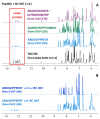Aptamer BC 007's Affinity to Specific and Less-Specific Anti-SARS-CoV-2 Neutralizing Antibodies
- PMID: 34069827
- PMCID: PMC8157297
- DOI: 10.3390/v13050932
Aptamer BC 007's Affinity to Specific and Less-Specific Anti-SARS-CoV-2 Neutralizing Antibodies
Abstract
COVID-19 is a pandemic respiratory disease that is caused by the highly infectious severe acute respiratory syndrome coronavirus 2 (SARS-CoV-2). Anti-SARS-CoV-2 antibodies are essential weapons that a patient with COVID-19 has to combat the disease. When now repurposing a drug, namely an aptamer that interacts with SARS-CoV-2 proteins for COVID-19 treatment (BC 007), which is, however, a neutralizer of pathogenic autoantibodies in its original indication, the possibility of also binding and neutralizing anti-SARS-CoV-2 antibodies must be considered. Here, the highly specific virus-neutralizing antibodies have to be distinguished from the ones that also show cross-reactivity to tissues. The last-mentioned could be the origin of the widely reported SARS-CoV-2-induced autoimmunity, which should also become a target of therapy. We, therefore, used enzyme-linked immunosorbent assay (ELISA) technology to assess the binding of well-characterized publicly accessible anti-SARS-CoV-2 antibodies (CV07-209 and CV07-270) with BC 007. Nuclear magnetic resonance spectroscopy, isothermal calorimetric titration, and circular dichroism spectroscopy were additionally used to test the binding of BC 007 to DNA-binding sequence segments of these antibodies. BC 007 did not bind to the highly specific neutralizing anti-SARS-CoV-2 antibody but did bind to the less specific one. This, however, was a lot less compared to an autoantibody of its original indication (14.2%, range 11.0-21.5%). It was also interesting to see that the less-specific anti-SARS-CoV-2 antibody also showed a high background signal in the ELISA (binding on NeutrAvidin-coated or activated but noncoated plastic plate). These initial experiments suggest that the risk of binding and neutralizing highly specific anti-SARS CoV-2 antibodies by BC 007 should be low.
Keywords: BC 007; COVID-19; SARS-CoV-2 antibody; aptamer; autoantibody; re-purposing.
Conflict of interest statement
Annekathrin Haberland, Peter Göttel, and Johannes Müller are employed at Berlin Cures GmbH. Annekathrin Haberland, Peter Göttel, and Johannes Müller are shareholders of Berlin Cures AG. Hardy Weisshoff is employed by a Transfer-Bonus co-operation project between the Humboldt-Innovation GmbH and Berlin Cures GmbH (TB2799/2020). A patent had been filed at the European Patent Office (no. 20 168 929.6) by the Berlin Cures GmbH. All other authors have nothing to declare. The authors have no other relevant affiliations or financial involvement with any organization or entity with a financial interest in or financial conflict with the subject or materials discussed in the manuscript apart from those which are disclosed.
Figures



Similar articles
-
Evaluation of SARS-CoV-2 neutralizing antibodies using a vesicular stomatitis virus possessing SARS-CoV-2 spike protein.Virol J. 2021 Jan 12;18(1):16. doi: 10.1186/s12985-021-01490-7. Virol J. 2021. PMID: 33435994 Free PMC article.
-
Scalable, Micro-Neutralization Assay for Assessment of SARS-CoV-2 (COVID-19) Virus-Neutralizing Antibodies in Human Clinical Samples.Viruses. 2021 May 12;13(5):893. doi: 10.3390/v13050893. Viruses. 2021. PMID: 34065987 Free PMC article.
-
Robust neutralizing antibodies to SARS-CoV-2 infection persist for months.Science. 2020 Dec 4;370(6521):1227-1230. doi: 10.1126/science.abd7728. Epub 2020 Oct 28. Science. 2020. PMID: 33115920 Free PMC article.
-
A Structural Landscape of Neutralizing Antibodies Against SARS-CoV-2 Receptor Binding Domain.Front Immunol. 2021 Apr 28;12:647934. doi: 10.3389/fimmu.2021.647934. eCollection 2021. Front Immunol. 2021. PMID: 33995366 Free PMC article. Review.
-
Overview of Neutralization Assays and International Standard for Detecting SARS-CoV-2 Neutralizing Antibody.Viruses. 2022 Jul 18;14(7):1560. doi: 10.3390/v14071560. Viruses. 2022. PMID: 35891540 Free PMC article. Review.
Cited by
-
Analysis of post COVID-19 condition and its overlap with myalgic encephalomyelitis/chronic fatigue syndrome.J Adv Res. 2022 Sep;40:179-196. doi: 10.1016/j.jare.2021.11.013. Epub 2021 Nov 26. J Adv Res. 2022. PMID: 36100326 Free PMC article. Review.
-
Functional nucleic acids as potent therapeutics against SARS-CoV-2 infection.Cell Rep Phys Sci. 2023 Feb 15;4(2):101249. doi: 10.1016/j.xcrp.2023.101249. Epub 2023 Jan 23. Cell Rep Phys Sci. 2023. PMID: 36714073 Free PMC article. Review.
-
Aptamers-Diagnostic and Therapeutic Solution in SARS-CoV-2.Int J Mol Sci. 2022 Jan 26;23(3):1412. doi: 10.3390/ijms23031412. Int J Mol Sci. 2022. PMID: 35163338 Free PMC article. Review.
-
Case Report: Neutralization of Autoantibodies Targeting G-Protein-Coupled Receptors Improves Capillary Impairment and Fatigue Symptoms After COVID-19 Infection.Front Med (Lausanne). 2021 Nov 18;8:754667. doi: 10.3389/fmed.2021.754667. eCollection 2021. Front Med (Lausanne). 2021. PMID: 34869451 Free PMC article.
-
Aptamer-engaged nanotherapeutics against SARS-CoV-2.Discov Nano. 2025 Apr 27;20(1):71. doi: 10.1186/s11671-025-04245-3. Discov Nano. 2025. PMID: 40289185 Free PMC article. Review.
References
-
- Becker N.-P., Haberland A., Wenzel K., Göttel P., Wallukat G., Davideit H., Schulze-Rothe S., Hönicke A.-S., Schimke I., Bartel S., et al. A Three-Part, Randomised Study to Investigate the Safety, Tolerability, Pharmacokinetics and Mode of Action of BC 007, Neutraliser of Pathogenic Autoantibodies Against G-Protein Coupled Receptors in Healthy, Young and Elderly Subjects. Clin. Drug Investig. 2020;49:433–447. doi: 10.1007/s40261-020-00903-9. - DOI - PMC - PubMed
-
- Haberland A., Holtzhauer M., Schlichtiger A., Bartel S., Schimke I., Müller J., Dandel M., Luppa P.B., Wallukat G. Aptamer BC 007—A Broad Spectrum Neutralizer of Pathogenic Autoantibodies against G-Protein-Coupled Receptors. Eur. J. Pharmacol. 2016;789:37–45. doi: 10.1016/j.ejphar.2016.06.061. - DOI - PubMed
-
- Müller J., Haberland A., Wallukat G., Becker N.-P., Wenzel K., Göttel P., Schulze-Rothe S., Schimke I., Yilmaz T., Abay A., et al. The DNA-Based Drug BC 007 Neutralizes Agonistically Acting Autoantibodies Directed Against G Protein–Coupled Receptors Successful Mode of Action Demonstrated in Clinical Phase 1 Trial. Chem. Today. 2019;37:65–67.
Publication types
MeSH terms
Substances
Grants and funding
LinkOut - more resources
Full Text Sources
Miscellaneous

